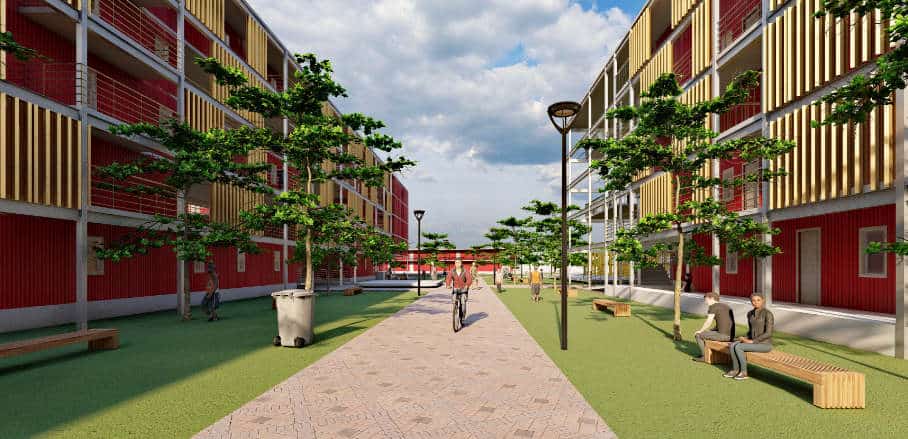Urban Space Era: A Disruptive Approach Towards a Resilient City
Delhi, just as many other cities around the world, struggles to provide adequate housing for migrant workers. Young architect Kaif Ali presents a potential solution.
Is your city resilient? Because mine is not! I live in one of the world’s most populated city; I live in Delhi.
What makes a city resilient, sustainable, or habitable is not only decided during prospering times but also in unpredictable and unforeseen circumstances. One example of such circumstances were the COVID-19 lockdowns, when more than 14 million people migrated from India’s cities back towards their villages, making it the second largest mass migration in India’s history after the country’s partition. What is the reason for this kind of migration, and what were its direct and indirect consequences? I’m taking India’s capital Delhi as an example to discuss the cause and call to action approaches!
In Delhi, there are more than one million day labourers, the majority of them lives in rental apartments or in JJ-Dwellings, which is an Indian term for slums. When after the sudden COVID-19 lockdown, there was no active employment for the workers, they had no money to pay for rent. The people had the choice to either reside in government-provided shelters or migrate back to their village.
The government provided homeless shelters: DUSIB shelters (Delhi Urban Shelter Improvement Board), also known as “Ran Basera”, which were already accommodating 20,000 inhabitants, accounting for 10 per cent of Delhi’s homeless population and had no further capacity to accommodate the recently homeless. The government opened new temporary shelters and schools for emergency sheltering, but they were no proper solution, featuring a lack of hygiene and not observing social distancing norms and basic necessities. These shelters even were among the major COVID-19 hotspots, with the virus transmitting gradually from shelter to the city and then to the whole country.
This led to no choice for workers but to migrate towards their villages, causing massive and sudden migration, with approximately 1.3 million migrating from Delhi alone, and causing panic among the regional and municipal governments of Delhi and the destination states.
Social and Economic Effects of COVID-19-Induced Migration
When people migrated, they carried the virusback to their villages, affecting already crumbling regional healthcare systems. Thousands of people travelled hundreds of kilometres on foot, many losing their lives in between.
Throughout India, approximately 14+ millions workers migrated back to their villages. Day labourers are the economic backbone of indian cities; their sudden migration and not coming back to cities created a massive economic loss as well as other problems, such as overflowing dump yards, stuck sewage lines, and high construction labour costs.
What Do We Need to Make a City Resilient?
Making a city resilient is just like reaching on Mars, or tackling climate change. It is not impossible, but it is difficult, because it needs the involvement of every strata of stakeholder, those who are the changemakers and those who are absorbing the change. A city is an organically growing organism – we cannot control it completely, but we can ensure and predict its performance through our current actions and policies.
For me as a young architect and entrepreneur working on disruptive housing solutions worldwide with my start-up Space Era, making a resilient city is defined by three Ps of society: PEOPLE (social responsibility), PROFIT (economic prosperity), and PLANET (environmental stewardship). Among the three aspects, PEOPLE is the most important aspect. By executing, practising, and involving concepts, innovations, policies, techniques, and ideas that are people-centred, we can gradually proportionate the other two Ps.
One such people-centred concept would be the architectural innovation and concept Urban Space Era ~ Urban Resilient Shelters for Pandemic or Post-Pandemic Era.
Urban – For urban migrants and workers
Space – A standard shelter space that is scalable or replicable
Era – Designed for the pandemic era and beyond
In metropolises like Delhi, governments have given permanent housing to workers in the outskirts of the city. But the economic opportunities are in the heart of city. Thus, workers prefer to stay in the central city on rental apartments. As governments cannot provide permanent housing in the city centre, temporary, modular housing solutions using contextual materials or prefabs can be the solution.
Such housing could ensure standard of living and be designed to fulfil social needs, particularly for migrant workers. These shelters should be designed with COVID-19 and other healthcare precautions in mind, as they are a major area of human interactions. The shelters or apartments could be standardised, with minor contextual incorporations, thus allowing for scalability and replications throughout the metropolises of the world. These solutions can also reduce the reverse migration by providing required shelter and thus contribute to urban resilience.
Today, all the major cities from Dhaka and New Delhi to Johannesburg and Mexico City are lacking in some aspect revolving around the 3Ps concept. They are becoming hubs for internal and international migration and rapid urbanisation causes yet new challenges to cities and their governments, including shelter needs while ensuring the basic necessities of an individual. Disruptive innovations like Urban Space Era could be an efficient and effective solution to meet the new challenges faced by the cities nowadays.
No, my city is not resilient, but yes! I am working to make it happen!
- Urban Space Era: A Disruptive Approach Towards a Resilient City - 30. August 2022
